|
 Phaeocollybia ratticauda Phaeocollybia ratticauda
BiostatusPresent in region - Indigenous. Non endemic
Images (click to enlarge)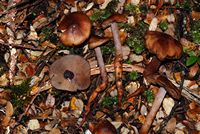
Owner: J.A. Cooper | 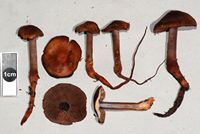
Owner: J.A. Cooper | 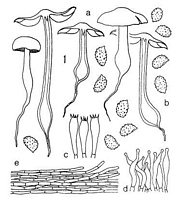
Caption: Phaeocollybia ratticauda
Hk. (type): a. carpophores. b. spores. c. basidia. d. cheilocystidia. e.
cuticle< | 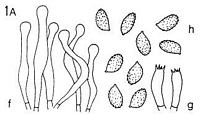
Caption: Phaeocollybia rancida
Hk. (ined.): f. cheilocystidia. g. basidia. h. spores | 
Caption: Phaeocollybia fallax
Smith (type): i. cheilocystidia. k. spores | 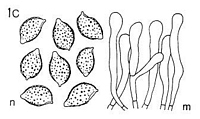
Caption: Phaeocollybia lilacifolia
Smith (type): m. cheilocystidia. n. spores | 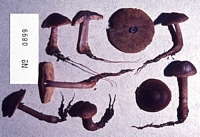
Caption: 899: Phaeocollybia raticauda
Owner: Egon Horak | 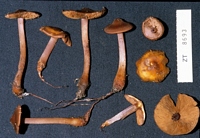
Caption: 8693: Phaeocollybia raticauda
Owner: Egon Horak | 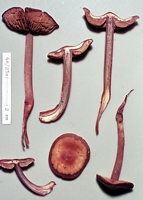
Caption: 68/230: Phaeocollybia ratticaua
Owner: Egon Horak | 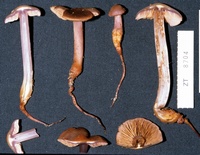
Caption: ZT8704
Owner: E. Horak: © Creative Commons Attribution-Noncommercial 3.0 New Zealand | 
Caption: Dried type specimen
Owner: Herb PDD |
Article: Horak, E. (1973). Fungi Agaricini Novazelandiae I-V. Beihefte zur Nova Hedwigia 43: 200 p.
Description: Pileus
15-45 mm broad, convex with inrolled margin when young becoming broadly umbonate
to campanulate then umbonate-expanded, dark brown to liver brown, opaque, fading
to ochraceous-brown or red-brown, dry, radially fibrillose to subsquamulose
in age, estriate. Lamellae adnexed to free, crowded, lilac or greyish-lilac
when young turning coffee brown then rust brown, gill edge concolorous or paler,
eroded. Stipe 50-100 x 3-6 mm, fusoid (up to 12 mm diam.) or abruptly attenuated
towards the base, with conspicuous pseudorhiza like a rat tail, dry, glabrous
or longitudinally fibrillose, ape lilac, towards the base orange-brown, tough,
hollow, single. Context deep lilac in upper portions of the stipe, brown in
pileus, orange at the base of the stipe. Taste and odor very unpleasant, like
burnt hairs. Chemical reactions on pileus: KOH - negative.
Spores
5-6 x 3.5-4 µm, ovoid, mucro absent, verruculose, ferruginous. Basidia 20-24
x 5-6 µm, 4-spored. Cheilocystidia 17-25 x 4-6 µm, subfusoid, with distinct
capitate apex (-2 µm diam.), hyaline, membrane thin-walled, scattered at gill
edge. Pleurocystidia lacking. Cuticle a cutis consisting of repent, cylindric,
not gelatinized hyphae (2-6 µm diam.), encrusted with brown pigment. Clamp connections
absent.
Habitat: Amongst
mosses in Nothofagus forests (N. menziesii, N. cliffortioides)
intermixed with Dacrydium cupressinum, Libocedrus bidwillii, etc. New
Zealand.
Notes: This
fungus is characterized by its lilac gills (see young carpophores), deep lilac
context at the upper portions of the stipe, ovoid spores, fusoid-capitate cheilocystidia
and its remarkable odor (like burnt hair). As far as we know there is only one
other closely related species known (Ph. rancida Hk. ined.) but the shape
of pileus and stipe, the odor and the shape of the cheilocystidia can be used
to separate clearly the two taxa.
Lilac coloured lamellae also occur in Ph. fallax Smith and Ph. lilacifolia
Smith. However, both North American taxa are distinguished from Ph. ratticauda
Hk. by their sublimoniform spores and the glutinous cuticle of the pileus.
From
the microscopic point of view the N.Z. fungus could be taken as Ph. radicata
(Murrill) Singer or Ph. rancida Hk. ined. but all other characters of
these fungi are different.
|